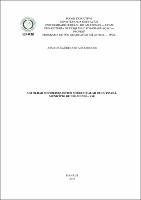| ???jsp.display-item.social.title??? |


|
Please use this identifier to cite or link to this item:
https://tede.ufam.edu.br/handle/tede/8017| ???metadata.dc.type???: | Dissertação |
| Title: | Um olhar sociolinguístico sobre o falar de Cutipanã, município de Nhamundá (AM) |
| ???metadata.dc.creator???: | Rodrigues, João da Saúde Costa  |
| ???metadata.dc.contributor.advisor1???: | Bandeira, Grace dos Anjos Freire |
| ???metadata.dc.contributor.referee1???: | Monteiro, Marta de Faria e Cunha |
| ???metadata.dc.contributor.referee2???: | Azevedo, Orlando da Silva |
| ???metadata.dc.description.resumo???: | As dimensões continentais do território brasileiro, aliadas à formação miscigenada de seu povo, são elementos relevantes na constituição multifacetária da variedade linguística do Português Brasileiro — PB. Para Labov (2008), todas as formas orais praticadas por falantes de qualquer região, grupo social, ou pequenas comunidades são objetos de estudo da Sociolinguística, mesmo que, dentro de uma mesma comunidade linguística, nem todos os membros falem exatamente a mesma língua, e a homogeneidade seja uma ficção (LYONS, 2013). Esse enfoque teórico-metodológico norteia os estudos dos fenômenos linguísticos variáveis praticados na comunidade de fala denominada Cutipanã, localizada no município de Nhamundá, no Amazonas. Este trabalho apresenta um estudo variacionista dos fatores linguísticos fonéticosfonológicos encontrados nos seguintes fenômenos: alçamento da vogal /o/ em posição átona final e em posição tônica, monotongação, ditongação, supressão em verbo e em nome, vocalização e nasalação, levando em conta os fatores extralinguísticos idade, sexo e escolaridade (MONTEIRO, 2000). Buscamos identificar se esses fenômenos e fatores apontam para tendências de manutenção ou de mudança de expressões conservadoras e quais contextos linguísticos e extralinguísticos favorecem ou inibem esse processo de variação (MOLLICA; BRAGA, 2003). Para a coleta do corpus, foram realizados os seguintes procedimentos: entrevistas, com gravação de áudio junto a informantes que ali vivem desde o seu nascimento, e aplicação de dois questionários fechados — o Fonético-Fonológico (QFF) e o Semântico-Lexical (QSL). Dessa forma, estudamos os metaplasmos, “indicadores de uma forma que não é normal, mas é admissível, e os que a empregam, ou a encontram, logo a associam à forma normal” (CÂMARA JR., 2011, p. 206). Os informantes foram divididos em células de acordo com as variáveis: sexo (homens e mulheres), faixa etária (11 a 24, 25 a 49 e 50 a 91 anos de idade) e grau de escolaridade (1º ano até o 7º ano do Ensino Fundamental e do 8º ano ao Ensino Médio completo), conforme Cezario e Votre (2012). Após o levantamento e a análise dos dados, os resultados da pesquisa foram apresentados na conclusão deste trabalho. |
| Abstract: | The multifaceted Portuguese Language spoken in Brasil and its linguistic variety are the result of the continental dimensions of the Brazilian territory, allied to the mixed formation of its people. However, the idea of respect and acceptance related to Linguistic Variation, advocated by Labov, is not always true. All oral forms practiced by speakers of any region, social group, or small community are important to variational sociolinguistics, even if in the same language community not all the members speak exactly the same language, and homogeneity may be a fiction (LYONS, 2013, p. 19). This theoretical-methodological approach guides the studies of the variable linguistic phenomena practiced in a speech community called Cutipanã, located in the city of Nhamundá, Amazonas. This paper investigated the phonetic, phonological and lexical internal linguistic factors and the external or social extralinguistic factors, such as age, gender and educational level (MONTEIRO, 2000, p. 58). We also seek to identify whether these factors indicate a variation or the stability in the speech of this community, as well as the contexts that favor or inhibit the emergence of innovative forms (MOLLICA; BRAGA, 2003, p. 11). To collect the “corpus”of the resarch, interviews have been conducted — using audio recording of informants who have lived there since birth —, and also through two closed questionnaires: the Phonetic-Phonological Questionnaire (PPQ) and the Lexical Semantic Questionnaire (LSQ). Thus we studied the metaplasms, the ones which “indicate a form that is not normal but admissible, and those who employ or find it soon associate it with the normal form” (CÂMARA JR., 2011, p. 206). The Informants were divided into cells by the following variables: gender (men and women); age group (11 to 24, 25 to 49 and 50 to 91 years old); and educational level (1st to 7th grade of elementary school and 8th grade to complete high school), according to Maria Maura Cezario e Sebastião Votre (2012, p. 150). The result of the collected data analysis in this research will be presented at the end of this paper. |
| Keywords: | Mudanças linguísticas Análise linguística Lingüística - Pesquisa |
| ???metadata.dc.subject.cnpq???: | LINGUISTICA, LETRAS E ARTES: LINGUISTICA |
| ???metadata.dc.subject.user???: | Variação Linguística Fonética Fonologia Cutipanã |
| Language: | por |
| ???metadata.dc.publisher.country???: | Brasil |
| Publisher: | Universidade Federal do Amazonas |
| ???metadata.dc.publisher.initials???: | UFAM |
| ???metadata.dc.publisher.department???: | Faculdade de Letras |
| ???metadata.dc.publisher.program???: | Programa de Pós-graduação em Letras |
| Citation: | RODRIGUES, João da Saúde Costa. Um olhar sociolinguístico sobre o falar de Cutipanã, município de Nhamundá (AM). 2019. 318f. Dissertação (Mestrado em Letras) — Faculdade de Letras, Universidade Federal do Amazonas, Manaus, 2019. |
| ???metadata.dc.rights???: | Acesso Aberto |
| ???metadata.dc.rights.uri???: | http://creativecommons.org/licenses/by/4.0/ |
| URI: | https://tede.ufam.edu.br/handle/tede/8017 |
| Issue Date: | 3-Dec-2019 |
| Appears in Collections: | Mestrado em Letras |
Files in This Item:
| File | Description | Size | Format | |
|---|---|---|---|---|
| Dissertação_JoãoRodrigues_PPGL.pdf | 5.35 MB | Adobe PDF |  Download/Open Preview |
This item is licensed under a Creative Commons License





